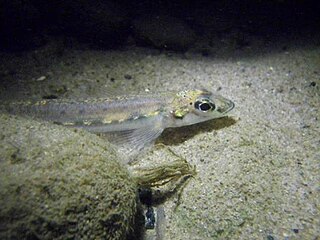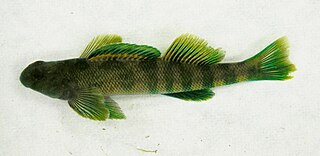
The walleye, also called the yellow pike or yellow pikeperch or yellow pickerel, is a freshwater perciform fish native to most of Canada and to the Northern United States. It is a North American close relative of the European zander, also known as the pikeperch. The walleye is sometimes called the yellow walleye to distinguish it from the blue walleye, which is a color morph that was once found in the southern Ontario and Quebec regions, but is now presumed extinct. However, recent genetic analysis of a preserved (frozen) 'blue walleye' sample suggests that the blue and yellow walleye were simply phenotypes within the same species and do not merit separate taxonomic classification.

The Percidae are a family of ray-finned fish, part of the order Perciformes, which are found in fresh and brackish waters of the Northern Hemisphere. The majority are Nearctic, but there are also Palearctic species. The family contains more than 200 species in 11 genera. The perches and their relatives are in this family; well-known species include the walleye, sauger, ruffe, and three species of perch. However, small fish known as darters are also a part of this family.

The zander, sander or pikeperch, is a species of ray-finned fish from the family Percidae, which also includes perch, ruffe and darter. It is found in freshwater and brackish habitats in western Eurasia. It is a popular game fish and has been introduced to a variety of localities outside its native range. It is the type species of the genus Sander.

The Sacramento perch is an endangered sunfish native to the Sacramento–San Joaquin River Delta, Pajaro, and Salinas River areas in California, but widely introduced throughout the western United States.

The yellow perch, commonly referred to as perch, striped perch or preacher is a freshwater perciform fish native to much of North America. The yellow perch was described in 1814 by Samuel Latham Mitchill from New York. It is closely related, and morphologically similar to the European perch ; and is sometimes considered a subspecies of its European counterpart.

The sauger is a freshwater perciform fish of the family Percidae that resembles its close relative, the walleye. The species is a member of the largest vertebrate order, the Perciformes. It is the most migratory percid species in North America. Saugers have two dorsal fins; the first is spiny and the posterior dorsal fin is soft-rayed. Their paired fins are in the thoracic position and their caudal fin is truncated, which means squared off at the corners, a characteristic of the family Percidae. Another physical characteristic of saugers is their ctenoid scales, which are common in advanced fishes. Saugers have a fusiform body structure, and as a result are well adapted predatory fishes and are capable of swimming into fast currents with minimal drag on their bodies. They may be distinguished from walleyes by the distinctly spotted dorsal fin, by the lack of a white splotch on the caudal fin, by the rough skin over their gills, and by their generally more brassy color, or darker color in some regions. The typical sauger is 300 to 400 g in weight.

Sander is a genus of predatory ray-finned fish in the family Percidae, which also includes the perches, ruffes, and darters. They are also known as "pike-perch" because of their resemblance to fish in the unrelated Esocidae (pike) family. They are the only genus in the monotypic tribe Luciopercini, which is one of two tribes in the subfamily Luciopercinae.

Ammocrypta is a genus of freshwater ray-finned fish, commonly known as the sand darters, which is classified in the subfamily Etheostomatinae, part of the family Percidae which also includes the perches, ruffes and pikeperches. The species in the genus occur in eastern North America in Canada and the continental United States.

Crystallaria is a genus of freshwater ray-finned fish which is classified in the subfamily Etheostomatinae, commonly known as the darters, part of the family Percidae which also includes the perches, ruffes and pikeperches. They are found in the Mississippi River basin from Ohio to Minnesota and in southern Mississippi, northern Louisiana, and southeastern Oklahoma, and on the Gulf Slope of Escambia, Mobile Bay, and the Pearl River drainages. They have now been extirpated from Ohio, Kentucky, Indiana, and Illinois.

Gymnocephalus is a genus of ray-finned fishes from the family Percidae, which includes the perches, pike-perches and darters. They are from the Western Palearctic area, although one species, Gymnocephalus cernua has been accidentally introduced to the Great Lakes region where it is regarded as an invasive species. They have the common name "ruffe" and resemble the true perches in the genus Perca, but are usually smaller and have a different pattern.

Percarina is a genus of ray-finned fish in the family Percidae found in eastern Europe. The genus is the only taxon in the monotypic subfamily Percarininae, which is characterised by having the first dorsal fin, having 9-11 spines and being widely separated from the second dorsal fin. They are thought to be closely related both to the perches of the genus Perca and to the ruffes of the genus Gymnocephalus.

Sander marinus, the estuarine perch, also called sea pikeperch or sea zander, is a species of ray-finned fish in the family Percidae which includes the perches, ruffes and darters. It is found in eastern Europe in the Black Sea and the Caspian Sea in Azerbaijan, Bulgaria, Iran, Kazakhstan, Moldova, Romania, Russia, Turkmenistan, and Ukraine. It lives in brackish water and rarely enters rivers.

The johnny darter is a species of freshwater ray-finned fish, a darter from the subfamily Etheostomatinae, part of the family Percidae, which also contains the perches, ruffes and pikeperches. It is native to shallow waters throughout North America east of the Rocky Mountains.

The Balkhash perch is a species of perch endemic to the Lake Balkhash and Lake Alakol watershed system, which lies mainly in Kazakhstan. It is similar to the other two species of perch, and grows to a comparable size, but has a slimmer build and is lighter in colour.
The emerald darter, is a species of freshwater ray-finned fish, a darter from the subfamily Etheostomatinae, part of the family Percidae, which also contains the perches, ruffes and pikeperches. It is found only in northern and eastern Kentucky and northeastern Tennessee.
The wounded darter is a species of freshwater ray-finned fish, a darter from the subfamily Etheostomatinae, part of the family Percidae, which also contains the perches, ruffes and pikeperches. It is endemic to the eastern United States. Its range includes the upper Tennessee River drainage, western Virginia, western North Carolina, and eastern Tennessee. Its typical habitat is among boulders or coarse rubble and cobble, often with overhanging ledges, in medium to large slow-moving rivers. It feeds on small insect larvae, especially midge larvae. Spawning occurs when the water warms up in late spring. Females deposit clutches of adhesive eggs on the underside of rock ledges or slabs, and the male guards the nest. The population trend of this fish seems to be decreasing slowly but it is a relatively common species with numerous sub-populations, and the International Union for Conservation of Nature has assessed its conservation status as being of "least concern". The greatest threat comes from impoundment, and a management plan is in place, including captive breeding.

Zingel zingel, the zingel, is a species of freshwater ray-finned fish in the family Percidae. It is found in fast-flowing streams in southeastern Europe. It is the type species of the genus Zingel.

The Luciopercinae is a subfamily of ray-finned fish, classified within the family Percidae, the subfamily includes the pike-perches and zingels. The pike-perches of the genus Sander have an Holarctic distribution while the zingels of the tribe Romanichthyini are found in Europe. They are largely freshwater species but some can be found in brackish water.

Etheostomatinae is a species-rich subfamily of freshwater ray-finned fish, the members of which are commonly known as the darters. The subfamily is part of the family Percidae which also includes the perches, ruffes and pikeperches. The family is endemic to North America. It consists of three to five different genera and well over 200 species. A common name for these fish in southern Indiana is pollywog.
















